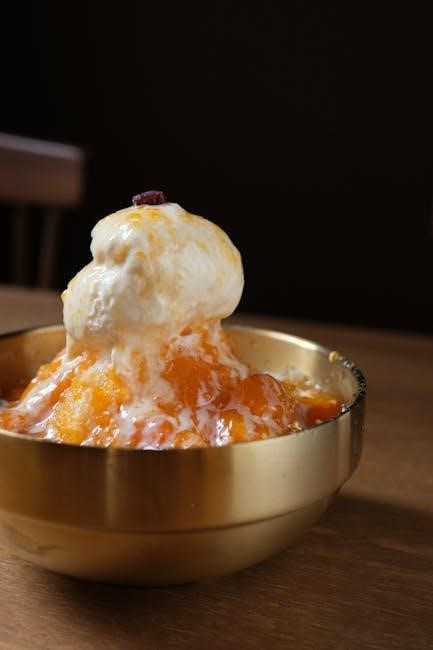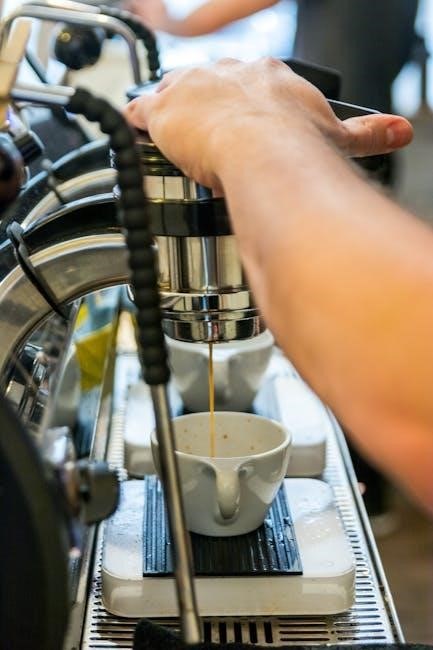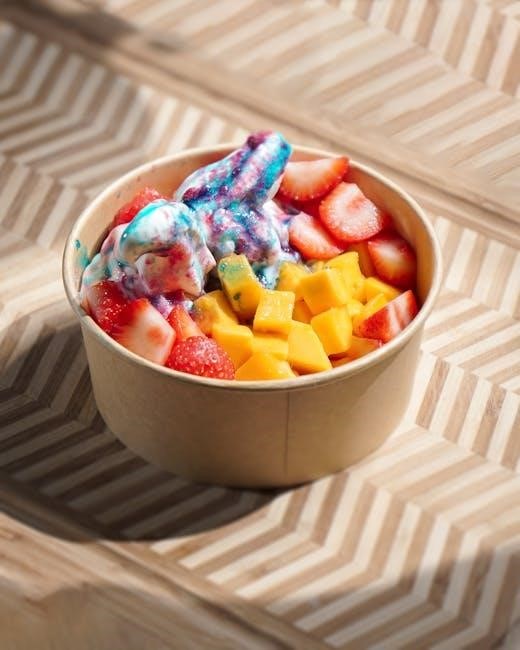Welcome to the world of homemade ice cream with the Cuisinart Ice Cream Machine! This guide will walk you through mastering your machine, from setup to creating delicious frozen treats. Whether you’re a beginner or an experienced user, these instructions will help you unlock the full potential of your Cuisinart Ice Cream Maker. Get ready to enjoy creamy textures, unique flavors, and endless customization options right in your own kitchen!
Overview of the Cuisinart Ice Cream Maker
The Cuisinart Ice Cream Maker is a versatile and user-friendly appliance designed to create delicious homemade ice cream with ease. Known for its simplicity and efficiency, it allows users to craft a variety of frozen treats, from classic ice cream to sorbet and gelato. The machine features an automated churning process, eliminating the need for manual effort. Its compact design makes it a perfect addition to any kitchen, while its durability ensures long-term performance. With minimal setup and cleanup, the Cuisinart Ice Cream Maker is a favorite among both novices and experienced dessert enthusiasts.
One of its standout features is the use of a pre-freezed bowl, which ensures quick and even freezing of ingredients. This results in a smooth and creamy texture that rivals store-bought ice cream. The machine’s intuitive controls and customizable options empower users to experiment with unique flavors and mix-ins. Whether you’re making a single batch or preparing for a gathering, the Cuisinart Ice Cream Maker delivers consistent results, making it a reliable tool for anyone passionate about creating artisanal frozen desserts at home.
Importance of Proper Usage and Safety Precautions
Proper usage and safety precautions are crucial when operating the Cuisinart Ice Cream Maker to ensure safe and efficient performance. Always read the user manual thoroughly before first use. Avoid overloading the machine, as this can damage the motor or lead to inconsistent results. Keep children away from the appliance while it is in operation. Ensure all components are properly assembled to prevent leaks or mechanical failure. Never submerge electrical parts in water, and avoid using abrasive cleaners that could harm the finish. Regularly inspect the machine for wear and tear. Following these guidelines helps maintain the machine’s longevity and ensures a safe, enjoyable ice cream-making experience.
Additionally, always use the machine on a stable, flat surface to prevent accidental tipping. Never leave the appliance unattended during operation, and keep loose clothing or long hair tied back. Proper handling of the frozen bowl and churning blade is essential to avoid injuries. By adhering to these precautions, users can create delicious homemade ice cream while minimizing risks and ensuring optimal machine performance over time. Safety should always be a priority to fully enjoy the benefits of this versatile kitchen appliance.
Understanding the Components of the Machine
The Cuisinart Ice Cream Maker consists of several key components designed for efficient ice cream production. The base houses the motor, which powers the churning process. The churn blade, attached to the lid, mixes and aerates the ingredients. The frozen bowl, pre-chilled to extreme temperatures, is essential for freezing the mixture. The clear lid allows monitoring of the process without interrupting it. Additional components include a spout for adding mix-ins and a control panel with simple operation buttons. Understanding each part ensures proper assembly, operation, and maintenance, leading to better results and prolonged machine lifespan. Familiarizing yourself with these elements is the first step to making perfect homemade ice cream.

Pre-Use Preparations
Ensure the machine is clean and dry. Freeze the mixing bowl for at least 6 hours. Chill ingredients in the refrigerator beforehand. Prepare mix-ins if desired.
Freezing the Bowl: Essential Steps
To ensure optimal performance, freeze the mixing bowl for at least 6 hours or overnight. Place the bowl in the coldest part of your freezer. Keep it level to avoid uneven freezing. Avoid opening the freezer frequently, as this can raise the temperature. Before use, confirm the bowl is fully frozen by checking its surface—it should feel uniformly cold and rigid. Do not store other items in the bowl while freezing. Proper freezing ensures even cooling during churning, which is crucial for smooth ice cream texture. Always handle the bowl with care to prevent accidental damage. This step is non-negotiable for success.
Pre-Chilling the Base for Optimal Results
Pre-chilling the ice cream base is a critical step before churning. Refrigerate the mixture for at least 1 to 2 hours to ensure it reaches a cold temperature. This step prevents ice crystals from forming during churning, resulting in a smoother texture. For faster cooling, place the base in an ice bath, stirring occasionally. Pre-chilling also allows flavors to meld, enhancing the final taste. A chilled base will churn more efficiently, producing a lighter and creamier consistency. Always use a food-safe container and cover it to prevent contamination. This preparation ensures your ice cream turns out perfectly every time.
Preparing Ingredients for the Best Texture
To achieve the best texture in your Cuisinart ice cream, start with fresh, high-quality ingredients. Use fresh milk and cream for a creamy base, ensuring they are well-chilled before mixing. Balance the ratio of cream to sugar to avoid iciness or overly sweet results. Fat content is crucial; heavy cream enriches texture, while substitutions may require adjustments. Prepare mix-ins like fruits or nuts by chilling and cutting them into uniform sizes. Pre-chill all ingredients to prevent ice crystals during churning. If using eggs, temper them properly to enhance emulsification. Allow the base to age in the fridge for a few hours to meld flavors and improve texture. This preparation ensures a smooth, creamy, and flavorful ice cream.

Making Ice Cream: A Step-by-Step Guide
Pour the chilled base into the pre-frozen bowl, churn until thickened, add mix-ins during the last 2 minutes, and transfer to an airtight container to freeze.
Mixing the Perfect Ice Cream Base
Mixing the ideal ice cream base is crucial for smooth, creamy results. Combine heavy cream, whole milk, and granulated sugar, whisking until the sugar dissolves. Add flavorings like vanilla extract or cocoa powder for depth. For richer textures, use higher milk fat content. Ensure ingredients are cold to prevent ice crystals. Avoid over-mixing, as it can incorporate too much air. For unique twists, infuse with fresh fruits, espresso, or liqueurs. Chill the base in the fridge for at least 2 hours before churning to allow flavors to meld. A well-balanced base ensures a delicious, professional-quality ice cream.
Churning Process: Tips for Ideal Consistency
The churning process in your Cuisinart Ice Cream Machine is vital for achieving the perfect texture. Pour the chilled base into the pre-frozen bowl and churn according to the machine’s instructions. Most models take about 20-30 minutes to transform the liquid into a smooth, creamy consistency. Avoid over-churning, as it can lead to an icy texture. For mix-ins like cookies or nuts, add them during the last 2 minutes of churning. Once done, the ice cream will resemble soft-serve. Transfer it to an airtight container and freeze for 2 hours to firm up. This ensures a scoopable, professional-quality finish.
Adding Mix-Ins and Flavorings
Enhance your ice cream by adding mix-ins and flavorings during the churning process. Introduce ingredients like chocolate chips, nuts, or fruit pieces once the mixture has thickened slightly. This ensures even distribution and prevents over-mixing. For flavorings, such as extracts or cocoa powder, incorporate them into the base before churning. Liquids like melted chocolate should be folded in during the last few minutes of churning. Be mindful of quantities to avoid overpowering the base. Experiment with unique combinations, like swirls of caramel or crushed cookies, for a personalized touch. This step allows creativity, making each batch truly one-of-a-kind. Always taste and adjust before final freezing.

Handling Different Desserts
The Cuisinart ice cream machine excels at crafting various frozen treats. Easily make sorbet, frozen yogurt, or gelato by adjusting ingredients and churning times. Customize flavors and textures for unique desserts, ensuring each batch meets your taste preferences. Experiment with mix-ins, fruit purees, or cocoa for variety. Troubleshoot consistency issues by refining base recipes. This versatility makes it a must-have for dessert lovers. Perfect for creating healthier options or rich, indulgent treats. Explore endless possibilities with this versatile kitchen appliance.
Creating Sorbet: Unique Considerations
For sorbet, use a base of fruit puree, sugar, and water. Ensure the mixture is smooth and not overly thick to prevent overloading the machine. Chill the base thoroughly before churning. Sorbet requires a slightly shorter churning time than ice cream to maintain its delicate texture. Avoid over-churning, as it can lead to an icy consistency. Add flavor enhancers like citrus zest or herbs for depth. Freeze the bowl beforehand for optimal results. Experiment with different fruits and flavor combinations to create refreshing, dairy-free desserts. Regularly scrape the sides during churning to ensure even freezing and a smooth finish.
Making Frozen Yogurt: Healthier Options
To make frozen yogurt, combine plain yogurt, sugar, and milk in a base mixture. Strain the mixture to remove excess liquid for a smoother texture. Pre-chill the base before churning. Use the Cuisinart machine on the frozen yogurt setting, if available, for the best results. Churn until the mixture reaches a soft-serve consistency, then freeze to firm up. Add fresh fruits or honey for flavor without extra sugar. Frozen yogurt is a healthier alternative to ice cream, with less fat and more probiotics. Experiment with non-dairy yogurts for vegan options. Avoid over-churning to prevent an icy texture and ensure a creamy finish.
Producing Gelato: Rich and Creamy Textures
Gelato is known for its dense, creamy texture, achieved by using more milk than cream and churning it slower. To make gelato with your Cuisinart machine, start with a base of whole milk, sugar, and a touch of heavy cream. Age the mixture in the fridge for 2-4 hours to develop flavor. Pour into the pre-chilled machine and churn until thickened. Gelato should be softer than ice cream when done. Transfer to an airtight container and harden in the freezer. For authenticity, use Italian-inspired flavors like hazelnut or pistachio. The machine’s slow churn setting helps create the smooth, velvety texture gelato is famous for, with less air incorporated than traditional ice cream.

Maintenance and Troubleshooting
Regular maintenance ensures optimal performance. Check and clean parts after each use. Lubricate moving components periodically. For issues, consult the user manual or contact customer support to prevent wear and tear.
Cleaning the Machine and Accessories
Clean the Cuisinart ice cream machine thoroughly after each use to maintain hygiene and functionality. Wash the mixing arm, lid, and paddle with warm, soapy water. Rinse all parts well and dry them completely. For tougher residue, soak components in warm water before scrubbing gently with a soft sponge. Avoid using abrasive cleaners or scouring pads, as they may damage surfaces. If dishwasher-safe, place parts on the top rack. Regular cleaning prevents bacterial growth and ensures smooth operation. Always wipe the motor base with a damp cloth and avoid submerging it in water.
Troubleshooting Common Issues
Addressing common issues with your Cuisinart ice cream machine ensures optimal performance. If the machine isn’t churning, check if the bowl is properly frozen or if the base is securely locked. For soft ice cream, ensure ingredients are chilled and the bowl is pre-frozen for at least 6 hours. If the motor overheats, allow it to cool down before reuse. Hard or icy texture may result from over-churning or incorrect ingredient ratios; Regularly inspect and clean the machine to prevent clogs. Refer to the user manual for specific error solutions, and always unplug the machine during troubleshooting for safety.
Replacing the Coolant: A DIY Solution
Replacing the coolant in your Cuisinart ice cream machine can be done at home with care. Start by unplugging the machine and allowing it to cool completely. Locate the coolant compartment, usually found in the base or near the motor. Use a compatible coolant designed for small appliances, available at hardware stores. Pour the coolant into the designated reservoir, ensuring not to overfill. Refer to the user manual for specific guidelines. Once replaced, reassemble the machine and test it by making a small batch of ice cream. Proper coolant levels ensure consistent churning and prevent overheating during use.

Recipe Ideas and Customization
Customize your ice cream with unique flavors like matcha, strawberry balsamic, or peanut butter cup. Add mix-ins such as candy pieces or nuts for texture and variety.
Classic Vanilla Ice Cream Recipe
To make classic vanilla ice cream, combine 2 cups of heavy cream, 1 cup of whole milk, and 1/2 cup of granulated sugar in a mixing bowl. Stir until the sugar dissolves. Add 1 teaspoon of pure vanilla extract for flavor. Cover and refrigerate the mixture for at least 2 hours to chill. Pour the chilled base into the Cuisinart ice cream machine and churn according to the manufacturer’s instructions. The churning process typically takes 20-25 minutes, resulting in a smooth, creamy texture. Transfer the ice cream to an airtight container and freeze for 2 hours to firm up before serving.
Incorporating Fresh Fruits for Unique Flavors
Fresh fruits add natural sweetness and vibrant flavors to your ice cream. Wash, hull, and slice or puree fruits like strawberries, raspberries, or mangoes before use. For smoother textures, strain seeds from berries. Mix the fruit into the base before churning or add it during the process for a ripple effect. Overripe fruits are ideal for deeper flavors. Experiment with combinations like peach-basil or pineapple-coconut for unique twists. For harder fruits like apples or pears, cook them briefly to soften. Always use fresh, high-quality fruits to ensure the best taste and texture in your homemade ice cream.
Adding Alcohol: Considerations and Effects
Adding alcohol to your ice cream can enhance flavors and create unique twists, but it requires careful consideration. Alcohol lowers the freezing point, resulting in a softer texture. Start with small amounts (1-2 tablespoons) of high-quality spirits, liqueurs, or extracts. Mix-ins like bourbon or rum pair well with vanilla, while coffee liqueur complements chocolate. Avoid overloading, as excessive alcohol can prevent proper freezing. For lighter flavors, use extracts like peppermint or almond. Always mix alcohol gently into the base before churning to ensure even distribution. Remember, alcohol-infused ice creams are best served immediately for optimal texture and flavor.

Safety Guidelines
Always unplug the machine before cleaning. Keep children away during operation. Avoid overloading the bowl. Use ingredients safely. Follow manual instructions for electrical safety.
Electrical Safety: Do’s and Don’ts
Ensure the machine is plugged into a grounded outlet to prevent shocks. Avoid using extension cords unless necessary and rated for the machine’s power. Never operate near water or in humid environments. Do not overload the outlet with other appliances. Avoid using damaged cords or plugs. Keep the machine away from children and pets while in use. Never mix wet ingredients near electrical components. Always unplug before cleaning. Follow the manufacturer’s guidelines for electrical connections. Regularly inspect cords for damage. If unsure, consult a professional. Prioritize safety to avoid hazards and ensure smooth operation. Always refer to the manual for specific electrical precautions.
Operating the Machine Safely
Always read the manual before first use to understand proper operation. Ensure the bowl is fully frozen and securely locked in place. Pour ingredients through the lid opening to avoid splashing. Never overfill the machine beyond the recommended capacity. Keep children supervised while the machine is running. Avoid touching moving parts or inserting utensils during operation. Use the provided churn paddle if needed. Store the machine on a stable, flat surface. Do not operate for extended periods beyond the recommended time. Turn off and unplug before cleaning or servicing. Regularly inspect for wear and tear. Follow all safety guidelines to ensure smooth and hazard-free operation. Always prioritize caution when handling the machine.
Storing the Machine and Accessories
After use, thoroughly clean and dry all parts to prevent moisture buildup. Store the machine in a cool, dry place, away from direct sunlight. The freezer bowl can be kept in the freezer for future use or cleaned and stored separately. Accessories like the lid, paddle, and mixing bowl should be dried and placed in a secure location. Avoid stacking heavy items on the machine to prevent damage. Always store the cord neatly to avoid tangling. For accessories like extra bowls, ensure they are stored in a protective covering. Regularly inspect stored items for signs of wear or damage before reuse. Proper storage ensures longevity and maintains performance quality.

Advanced Techniques
Explore advanced methods like refining recipes, experimenting with unique ingredients, and mastering churning speeds for smoother results. These techniques elevate your ice cream-making skills.
Temperature Control for Perfect Churn
Accurate temperature control is crucial for achieving smooth, creamy ice cream. Ensure the mixing bowl is fully frozen (typically 6-12 hours) and ingredients are chilled to 40°F or below. Cold bases churn more efficiently, preventing ice crystals. Monitor the machine’s temperature during operation, ideally maintaining a consistent churn temperature between 20-25°F. Overheating can lead to soft or icy textures. For optimal results, pre-chill all components and avoid overloading the machine. Proper temperature management ensures a uniform freeze, resulting in a professional-quality finish every time.
Using a Thermometer for Consistency
A thermometer is an essential tool for ensuring consistent results when making ice cream. It helps monitor the temperature of both the base and the machine during churning. Aim for a base temperature between 40°F and 45°F before churning to prevent ice crystals. Use the thermometer to check the machine’s bowl temperature, ideally around 20°F during operation. Consistent temperatures ensure a smooth, even churn and a creamy texture. Place the thermometer in the mixture during the early stages of churning to track progress. This precision guarantees professional-quality ice cream every time, avoiding over-churning or under-churning.
Preventing Ice Crystals: Tips and Tricks
Ice crystals can ruin the smooth texture of homemade ice cream. To prevent them, ensure your base is aged in the refrigerator for at least 2 hours to allow flavors to meld. Use a mixture with the right balance of sugar and fat, as excess water leads to crystals. Churn at the correct speed to incorporate minimal air. Avoid over-freezing, as this causes ice formation. Add mix-ins midway through churning to avoid introducing cold spots. For optimal results, transfer the ice cream to an airtight container after churning and store at 0°F. Regularly tasting ensures quality and prevents over-hardening.

Storage and Freezing
Store homemade ice cream in an airtight container at 0°F to maintain quality. This prevents freezer burn and ice crystals, ensuring a smooth texture.
Storing Homemade Ice Cream
To maintain the quality and texture of your homemade ice cream, store it in an airtight, shallow container with a tight-fitting lid. Place plastic wrap or wax paper directly on the surface to prevent ice crystals from forming. Keep it in the coldest part of your freezer, ideally at 0°F (-18°C), to slow down crystallization. Avoid frequent thawing and refreezing, as this can degrade the texture. For longer storage, divide the ice cream into smaller portions to make freezing and serving more convenient. Label and date the containers for easy identification. Proper storage ensures your ice cream remains creamy and fresh for weeks.
Freezing Tips for Long-Lasting Quality
For optimal freezing, place the ice cream in an airtight container with minimal headspace to prevent air exposure. Press plastic wrap directly onto the surface to avoid ice crystals. Freeze at 0°F (-18°C) for the best texture. Divide the mixture into shallow layers or small portions to freeze evenly. Label containers with dates for easy tracking. Store in the coldest part of the freezer to maintain consistency. Avoid cross-contamination by keeping the container clean. Proper freezing ensures a smooth, creamy texture and prevents off-flavors. Regularly check the container to ensure it remains airtight for long-lasting quality and freshness.
Avoiding freezer Burn: Best Practices
Avoiding Freezer Burn: Best Practices
To prevent freezer burn, ensure your ice cream is stored in an airtight container with minimal air exposure. Use high-quality plastic wrap or aluminum foil to cover the surface before placing the lid. Divide the mixture into smaller portions to minimize exposure during serving. Store the container in the coldest part of the freezer, typically the bottom shelf. Regularly check the seal to ensure it remains tight. Label containers with dates to monitor storage time. Freezer burn occurs when moisture evaporates, creating ice crystals, so maintaining airtight conditions is crucial for preserving texture and flavor over time.

Concluding your journey with the Cuisinart ice cream machine, remember that practice makes perfect. Experiment with recipes, and enjoy the fruits of your labor. Happy churning!
With patience and creativity, you’ll master the art of crafting delicious homemade desserts tailored to your taste preferences.
Final Tips for Mastery
To truly master your Cuisinart ice cream machine, experiment with flavors and ingredients to find your perfect combinations. Pay attention to ingredient ratios, as they impact texture and consistency. Regularly clean and maintain the machine to ensure optimal performance. For the best results, pre-chill all components and ingredients before churning. Don’t overfill the bowl, as this can disrupt the churning process. Store homemade ice cream in airtight containers to preserve freshness. Practice makes perfect, so don’t be discouraged by early batches—adjust and refine your techniques over time. With patience and creativity, you’ll achieve professional-quality desserts at home.
Encouragement to Experiment and Enjoy
Embrace the joy of creating unique desserts with your Cuisinart ice cream machine! Experiment with diverse flavors, from classic vanilla to bold mix-ins like caramel, nuts, or candy pieces. Don’t hesitate to try unconventional ingredients, such as herbs or spices, to craft one-of-a-kind recipes. Remember, every batch is an opportunity to innovate and refine your skills. Share your creations with friends and family, and enjoy the satisfaction of serving homemade treats. With practice, you’ll unlock endless possibilities and make every dessert moment memorable. Happy churning and savoring the sweet rewards of your creativity!
